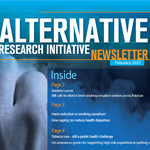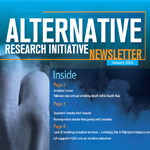Research Articles
Bill introduced in Senate calls for regulating use and sale of e-cigarettes in Islamabad (December 03, 2025)
ISLAMABAD: A bill has been introduced in the Senate to regulate the Electronic Nicotine Delivery Systems (ENDS), popularly known as e-cigarettes, in Pakistan’s capital Islamabad. Click for detail
Make Smoking Cessation Central to Tobacco Control Strategy (August 2025)
Despite decades of tobacco control campaigns, graphic warnings, bans on advertising, and tax hikes, Pakistan remains trapped in a cycle of tobacco dependency. Over 31 million Pakistanis use tobacco in some form, and smoking-related illnesses claim over 160,000 lives annually. However, the smoking cessation remains ignored and almost forgotten, leaving the adult smokers who want to quit without any assistance. Click for detail
Pakistan's Struggle to Regulate Alternative Tobacco Products (August 2025)
Pakistan has been unable to come up with regulation regarding alternative tobacco products – electronic cigarettes and nicotine pouches. There have been calls to ban these alternative tobacco products. The Punjab government did ban the outlets selling electronic cigarettes, but the Lahore High Court overturned the ban.
Click for detailTobacco control: Bridging the gap from awareness to action (July 2025)
Despite decades of tobacco control, smoking remains one of the most persistent public health threats in Pakistan. While awareness campaigns have succeeded in highlighting the dangers of tobacco use, the country continues to grapple with disturbingly high prevalence rates, weak policy enforcement, and a glaring omission—smoking cessation services.
Click for detailMake tobacco awareness education part of school and college curricula (May 2025)
Tobacco use remains a significant public health challenge in Pakistan, with rising youth smoking rates and the persistent threat of tobacco-related diseases. Young people continue to be vulnerable to the lure of cigarettes. In Pakistan, 10.7% of youth (ages 13-15) use tobacco products, with 7.2% smoking tobacco and 5.3% using smokeless tobacco. Alarmingly, among youth who have ever smoked, nearly 40% first tried a cigarette before age 10, and 37.8% of youth (ages 13-15) are exposed to secondhand smoke in public places, while 21% are exposed at home.
Click for detailProtecting young people from smoking (March 2025)
Smoking remains a significant public health challenge in Pakistan, particularly among young people. Despite widespread awareness of its harmful effects, tobacco use continues to rise among adolescents and young adults. Recent studies indicate that 17.2% of Pakistan's population smokes, with male smokers accounting for 28.4% and female smokers 6%. The age group most affected falls between 25 to 44 years, but smoking is increasingly penetrating adolescent demographics.
Click for detailPath to a Smokefree Future (May 2025)
As we are now in the month of World No Tobacco Day, which falls on May 31 every year, it is pertinent to review the smoking prevalence in Pakistan. Unfortunately, smoking prevalence remains a significant public health concern. The adult smoking rate is estimated to be around 20.2%, with approximately 15.6 million smokers in the country. Tobacco use continues to contribute to a substantial burden on the healthcare system.
Click for detailStarting a healthier, happier life (April 2025)
The decision to quit smoking is a life-changing step forward. It is a step towards better health and a life without smoke. However, there are significant challenges in achieving the aim of quitting smoking. Withdrawal symptoms, mood swings, and cravings can make the journey tough. However, with persistence and the right strategies, a smoker can navigate this phase effectively and embrace a smoke-free life.
Click for detailRole of parents in preventing smoking among children (April 2025)
Smoking continues to be a significant health issue worldwide, including in Pakistan, where tobacco consumption is deeply rooted in societal habits and cultural practices. Despite increasing awareness about its harmful effects, smoking remains a challenge, especially among youth who are often vulnerable to peer pressure and media influence.
Click for detailAddressing Pakistan's Smoking Crisis (March 2025)
When one is grappled with the question of ending smoking in Pakistan, one is overwhelmed by the enormity of the challenge. How can a country with more than 31 million tobacco users achieve the target of a smoke-free country? A tall order, indeed. More than half of the tobacco users – 17.3 million - are smokers. Click for detail
ARI Newsletter February 2025 (March 12, 2025)
Alternative Research Initiative (ARI) and its Punjab partners held meetings with adult smokers, vapers, and tobacco users to help them quit and achieve a smoke-free Pakistan. In February, the meetings were conducted by Future Development Foundation in Sargodha, Maimar Development Organization in Faisalabad, Sun Consultant and Enterprises Services in Multan, Dove Foundation in Bahawalpur, Al-Emaan Development Organization in Dera Ghazi Khan, and Dove Foundation in Lahore. Click for detail
Tobacco use - still a public health challenge (February 2025)
Smoking is one of the leading causes of preventable deaths worldwide, claiming millions of lives annually. Despite widespread awareness of its harmful effects, tobacco use remains a significant public health challenge, particularly in countries like Pakistan.
Click for detailARI Newsletter January 2025 (February 17, 2025)
Alternative Research Initiative (ARI) and its Sindh partners have conducted meetings with adult smokers, vapers and tobacco users, aiming to help adult smokers quit and achieve a smoke-free Pakistan. Click for detail
اردو مضامین
ترک سگریٹ نوشی کی مخالفت کیوں؟، ارشد رضوی

پاکستان سن 2002 میں ورلڈ ہیلتھ آرگنائزیشن ( ڈبلیو ایچ او ) کے فریم ورک کنوینشن آن ٹوبیکو کنٹرول (FCTC) کا رکن بنا تھا، تب سے اب ( 2023 ) تک اکیس سال گزر چکے ہیں پاکستان (اور دنیا بھر) میں سگریٹ نوشوں میں اضافہ ہی ہوا ہے۔ ایک رائے کے مطابق دو کروڑ نوے لاکھ ( 29,000,000 ) جبکہ بعض رپورٹس تین کروڑ دس لاکھ ( 31,000,000 ) سگریٹ نوشوں کی موجودگی کی بات کرتی ہیں، اگر پچیس کروڑ کی آبادی مان لی جائے تو پاکستان میں 12 فیصد آبادی تمباکو استعمال کرتی ہے۔
ترک سگریٹ نوشی میں مدد گار متبادل، ارشد رضوی

سگریٹ یا تمباکو نوشی کے نقصان دہ اثرات کے بارے میں ستر سال قبل ہونے والی ایک سٹڈ ی میں بتایا گیا تھاتب سے اب تک دنیا میں کروڑوں لوگ تمباکو سے متعلق بیماریوں کے باعث موت کی تاریک وادی میں جا چکے ہیں
صحت، تمباکو اور ریونیو، ارشد رضوی

تمباکو نوشی کا انسان سے رشتہ بہت پرانا ہے۔ تمباکو اور اس سے متعلق مصنوعات کی طویل تاریخ ہے جو 6000سال قبل مسیح میں ملتی ہے۔مقامی امریکیوں کے بارے میں کہا جاتا ہے کہ انہوں نے پہلے تمباکو کی کاشت شروع کی اور یہ 6000سال قبل مسیح میں ہی ہوا۔
انسانی صحت اور عالمی ادارہ صحت، ارشد رضوی

اگر عالمی ادارہ صحت کچھ مختلف طرزِ عمل اختیار نہیں کرتا اور تمباکو پالیسی میں جدّت کو قبول نہیں کرتاتو ادارہ دل، کینسر اور پھیپھڑوں کے امراض میں کمی کے اہداف کے حصول میں بہت پیچھے رہ جائے گا۔
جو فرد سگریٹ نوشی ترک کرنا چاہتا ہے اس کی نیکوٹین کی طلب اور نفسیات کو سامنے رکھتے ہوئے کونسلنگ کی ضرورت ہے، ڈاکٹر احسن لطیف

اگر ہم چاہتے ہیں کہ سگریٹ نوشی ختم ہو جائے تو سگریٹ پینے والوں کواس بارے میں تمام بحث میں سب سے آگے ہونا چاہئے تاکہ وہ اپنی ضرورتوں کا خیال رکھ سکیں۔
ما قبل کورونا اور ما بعد، ارشد رضوی

کورونا کے مابعد اثرات میں ایک خوفناک ترین اثر بڑے پیمانے پر دنیا کی آبادی کے ایک بڑے حصے کا خطِ غربت سے نیچے گِرنے کا اندیشہ ہے جس کے نتیجے میں بے روزگاری اور غربت میں غیر معمولی اضافہ ہو گا۔
OUR PROJECTS
Pakistan is a country with heavy use of tobacco. With more than 24 million...
Read MoreRESEARCH ARTICLES
The Birth of Harm Reduction Informs the World's Need for Safer Nicotine...
Read MoreWHAT WE DO?
Alternative Research Initiative (ARI) works to provide researched-based solutions...
Read More












